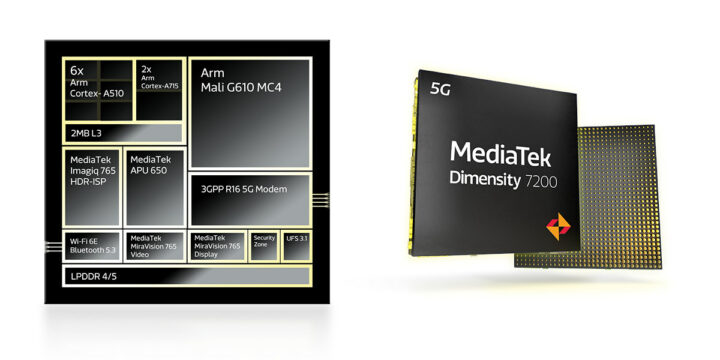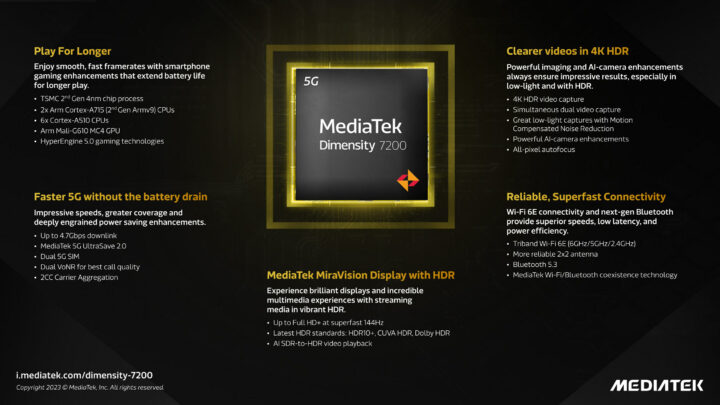Manufactured with a 4nm processor, the MediaTek Dimensity 7200 is an octa-core Armv9 processor designed for mainstream smartphones. with two Cortex-A715 cores, six Cortex-A510 cores, a Mali-G610 MC4 GPU, as well as 5G, WiFi 6E, and Bluetooth 5.3 connectivity.
So far, I had only seen Armv9 SoCs with a mix of Cortex-A510 “LITTLE” cores, Cortex-A710/A715 “big” core, and Cortex-X2 or Cortex-X3 “flagship cores” as found in the Dimensity 9200 processor, but the Dimensity 7200 is one of the first Armv9 processors – one other being the Snapdragon 7 Gen 1 – without a Cortex-X core in order to provide a more affordable solution.
MediaTek Dimensity 7200 specifications:
- CPU
- 2x Arm Cortex-A715 up to 2.8GHz
- 6x Arm Cortex-A510
- 2MB L3 cache
- GPU – Arm Mali-G610 MC4 with MediaTek HyperEngine 5.0
- APU – MediaTek APU 650 AI accelerator
- DPU/VPU – MediaTek MiraVision 765 engine for display and 4K HDR video decoding/encoding
- Memory I/F – LPDDR4/5 up to 6400Mbps
- Storage I/F – UFS 3.1
- Display – Full HD+ up to 144Hz with global HDR (HDR10+, CUVA HDR and Dolby HDR)
- Camera
- MediaTek Imagiq 765 with 14-bit HDR ISP
- Dual Simultaneous Video Capture
- 200MP Max
- Connectivity
- Tri-band Wi-Fi 6E 2×2 MIMO (6, 5, 2.4GHz)
- Bluetooth 5.3 with LE audio and dual-link True Wireless stereo audio support
- 5G
- Sub-6GHz (FR1) up to 2CC (200MHz), NR TDD/FDD, 3GPP R16
- Dual 5G SIM (5G SA + 5G SA) & Dual VoNR
- Up to 4.7Gbps downlink
- MediaTek 5G UltraSave 2.0
- Process – TSMC N4 (4nm-class)
It is the first processor from the Dimensity 7000 family, and MediaTek did not talk about performance, probably because it’s meant to be a cost-down version of the Dimensity 9000 series, and showing lower numbers in a press release would not look good from a marketing point-of-view :).
MediaTek says the Dimensity 7200 will be found in 5G mobile devices this quarter (Q1 2023). Additional information may be found on the product page. Hopefully, this marks the start of more affordable Armv9 SoCs and not only for mobile. Time will tell.
Thanks to TLS for the tip.

Jean-Luc started CNX Software in 2010 as a part-time endeavor, before quitting his job as a software engineering manager, and starting to write daily news, and reviews full time later in 2011.
Support CNX Software! Donate via cryptocurrencies, become a Patron on Patreon, or purchase goods on Amazon or Aliexpress







That core configuration and the TSMC 4nm process should make it very efficient.
Does anyone aware of indicative prices for these CPUs? I know MediaTek and Qualcomm keeps it secret, there are should be some leaks somewhere
Unless you come witha 100k+ order, they’re not likely to even talk to you. I’ve tried working with them in the past, as it’s impossible, unless you have an inside contact or a big potential customer. This makes pricing kind of irrelevant. That said, they should be more cost efficient than Qualcomm, but that doesn’t say much. The worst thing, with both companies, is software support.
I’ve been involved in projects using chips from both companies and they’re equally bad. We found a bug in MTK’s WiFi drivers back then and it took them three months just to respond to the issue and another three to fix it…
Honestly, it’s harder to track because they only sell those to certified partners and they always sell with support available. Also only sell in huge quantities and after some negotiation involving when to deliver and stuff like that.
It’s not like a company like Xiaomi orders 10k units of a SoC on Digikey and get them delivered in a couple of weeks.
Mediatek says there will be products out “end of March latest” so it should be possible to infer pricing at that time based on those products’ specs relative to other products.
As a mid-tier SoC though, it should be expected to make up about 1/4 the cost of the phone/tablet, which in turn makes up about 1/8th to 1/12th the retail cost of those devices, where the manufacturer/wholesaler stream is getting about 40% and the retailer is getting about 60% of the 100%-150% markup from cost. The retailer gets more because they have to advertise and they also accept more risk in passing the products along to consumers, who need support, and bluntly, there’s a share of consumers who abuse the returns/warranty system, elevating prices for everyone else.
Digressing. So you can expect the SoC to be about $50 of the $500USD cost of a mid-tier phone. And that SoC price doesn’t include RAM and storage, but may include supporting components, ie crystals, caps, resistors, PMIC, buck converters, bootstrap MCU and serial flash, RF amp, connectors, possibly integrated RAM will be an incremental cost.
If your real question was “what would it cost for me to make an SBC based on this”, you can take that $50, and multiply it by 10 for an order of 1000 units, so $1/2 M at cost, because Mediatek would need to invest $400k of developer hours into supporting your company to bring the product to market. You’d need to invest even more on your side, so your actual cost would probably be more like $1500 per unit by the time you brought it to market. Now you know why ARM laptops are so pricey. And now you have huge respect for companies like RPi Fnd., Pine64.org, Radxa, etc who are killing themselves making no money to bring products to the community, and why they are using 3+ year-old SoC’s which other companies already paid the lion’s share of platform integration dev costs for.
without armv9 developer boards, there’s fewer community for software development, before releasing mass consumer boards for Linux distributions and advanced, wide range firmware support (if new SoC’s (armv9/Risc-V) affect peripheral’s drivers?) and even if there are cheap capable armv9 SoCs available on mass phones/tablets, it might take another 2-3yrs (?) before they appear on consumer level (and prized) media and universal use platforms/SBCs (?)
“$500USD cost of a mid-tier phone” what is out of competition within a 2-3yrs considering top level hw(->software) development (?)
(and for average usage, these SoCs are already on office ~desktop level performance)
Agreed. The community software development support far exceeds this claimed $400K of support from the SoC manufacturer.
First mobile vender to provide rk3588 power in a £150 handheld will have a killer product if marketed right.
As a smartphone, handheld console, laptop SoC.
Only IMO..
😏